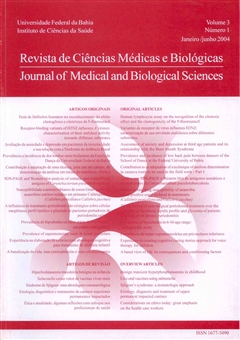Prevalence of hypodontia in 6-16 age range: radiographic study
DOI:
https://doi.org/10.9771/cmbio.v3i1.4411Keywords:
Hypodontia, Dental anomalies, Panoramic radiograph, Prevalence.Abstract
Hypodontia, an anomaly that presents lack of development of one or more teeth, has been frequently detected in pediatric patients. Researches show this disease prevalence in many populations, however, due to ethnic and genetic differences, these results cannot be generalized. Being aware ofthe importance of panoramic radiographs in the diagnosis of dental development disturbs, two examiners, previously calibrated, analyzed 678 patients' radiographs who were assisted at the Radiology Service of the OdontologyCollege of PUCRS, between 2000 and 2002. The aim was to determine the prevalence in patients aged six to sixteen, by pointing out the affected teeth, their location and their distribution concerning the genders. Hypodontia was found in 17 cases (2,5%). With x2 test, no relevant relation between hypodontia and genders was found (p=0,271). The most absent teeth were the superior lateral incisors, followed by the superior premolars. There was no relevant difference related to location, therefore, it may happen uni- (47%) and bilaterally (53%). These findings make it possible to consider that hypodontia is a dental development anomaly more and more frequently in different population; its precocious diagnosis is vitally important in the prevention of maxillary-mandibular disturbs. The panoramic radiograph is vital in the detection of these anomalies and, when previously done, it permitus to establish a clinical and orthodontic conduct in the appropriate time.Downloads
Download data is not yet available.
Downloads
Published
2004-01-01
How to Cite
Silva, D. N., Cancino, C. M. H., Batista, P. S., & Robinson, W. M. (2004). Prevalence of hypodontia in 6-16 age range: radiographic study. Journal of Medical and Biological Sciences, 3(1), 69–75. https://doi.org/10.9771/cmbio.v3i1.4411
Issue
Section
ORIGINAL ARTICLES
License
The Journal of Medical and Biological Sciences reserves all copyrights of published works, including translations, allowing, however, their subsequent reproduction as transcription, with proper citation of source, through the Creative Commons license. The periodical has free and free access.


